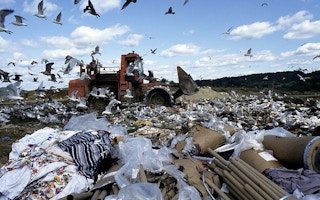We take out our trash and feel lighter and cleaner. But at the landfill, the food and yard waste that trash contains is decomposing and releasing methane, a greenhouse gas that’s 28 times more potent than carbon dioxide. Landfill gas also contributes to smog, worsening health problems like asthma.
Globally, trash released nearly 800 million metric tons (882 million tons) of CO2 equivalent in 2010 — about 11 per cent of all methane generated by humans. The United States had the highest total quantity of methane emissions from landfills in 2010: almost 130 million metric tons (143 million tons) of CO2 equivalent.
China was a distant second, with 47 million (52 million), then Mexico, Russia, Turkey, Indonesia, Canada, the United Kingdom, Brazil and India, according to the Global Methane Initiative, an international partnership of government and private groups working to reduce methane emissions.
Because methane typically has a much shorter life in the atmosphere than CO2 (12 years compared with 100 to 300 years for carbon dioxide), reducing methane release from landfills can help rapidly reduce climate change risk.
“
Let’s feed people, not landfills.
Gina McCarthy, administrator, U.S. Environmental Protection Agency
Capture and use
For 20 years, the U.S. Environmental Protection Agency has required some landfill operators (generally those with larger facilities) to control methane emissions by installing gas collection systems. To capture it, operators insert vertical wells into the waste and use vacuum pressure to suck up the gas.
After capture, the gas can be processed and used in different ways. Because methane is the main component of natural gas, it can be captured and burned for energy with a much lower climate impact than letting it seep out.
Three-fourths of these projects in the United States burn methane to generate electricity, according to the EPA. The captured methane also can be piped to nearby industrial customers or compressed to make compressed natural gas or cooled to make liquefied natural gas to power vehicles, as Waste Management, one of the two primary landfill companies in the United States, did for some of its garbage trucks in California.
Or it can be cleaned to a higher standard and put into a natural gas pipeline, joining the larger gas supply, a method Waste Management has employed at its Milam Landfill in Fairmont City, Illinois. In some cases, it’s not put to beneficial use but is burned off to convert the potent methane to less intense global warming emissions.
Currently the United States has 652 landfill methane capture facilities with a capacity of 2,163 megawatts. Over the past 20 years, these projects have reduced and avoided the release of more than 345 million metric tons (380 million tons) of CO2 equivalent, which is approximately equal to 73 million cars being taken off the road for a year.
But that achievement seems rather modest when considering another EPA statistic: U.S. landfills released an estimated 148 million metric tons (163 million tons) of CO2 equivalent to the atmosphere in 2014 alone — a figure that includes both municipal waste landfills and industrial landfills, some of which have gas collection facilities and some of which don’t.
In July, EPA published new rules tightening regulations related to methane emissions from landfills. The agency claims the move will reduce methane emissions by 8.2 million metric tons (9 million tons) of CO2 equivalent a year beginning in 2025, approximately equal to taking 1.7 million cars off the road for one year.
Gas projects
But according to Peter Anderson, a waste management consultant who has advised the EPA on landfills’ greenhouse gas emissions, gas capture facilities are not particularly effective because of the nature of methane and landfill operations. Methane-producing bacteria flourish when there is no oxygen, a condition called anaerobic. Landfills go through various stages: open, open with a cover that still lets in some oxygen, and closed with an impermeable seal.
When a landfill is open to receiving more trash, it doesn’t have a seal, making the vacuum draw somewhat ineffective. But by the time a landfill is sealed, it has released most of the methane it is going to. These operating realities mean that “gas collection doesn’t work when the gas is generated, and it does work when no gas is being generated,” said Anderson.
This story was published with permission from Ensia.com. Read the full story.








